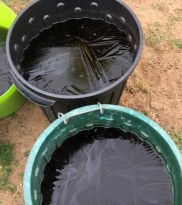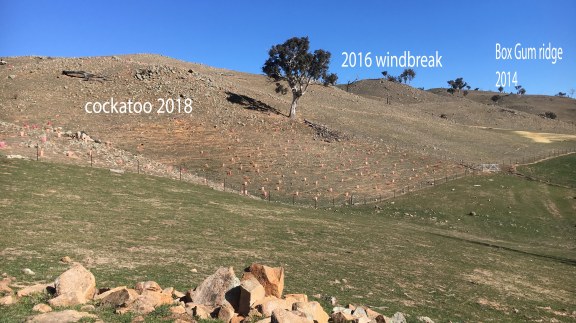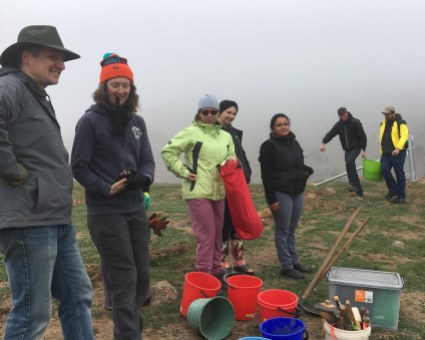Amazingly, we’re done with our main project for 2018!
After the bitter weather on our big planting a few weeks ago, I was worried we’d never get our whole Glossy Black Cockatoo project finished. Thankfully, Darren Menachemson and a wonderful crew from ThinkPlace plus a Greening Australia “Adopt a Plot” team came to our rescue.
The lovely ThinkPlacers turned up on a foggy morning and chose the highest ridge to plant.

We had to chase out a family of kangaroos that were still confused by the new fences. We also had to crack the ice on the frozen water buckets we’d stashed ahead of time. Brrrr.
They (the people, not the kangaroos) were a great team, both careful and fast. We had the assistance of mascots in the form of dogs and toddlers, which always adds to the entertainment.
By the time we called a halt, they’d got 170 more allocasuarinas into the ground among the rocky ridges. It’s going to look extraordinarily different when they all grow. Planting definitely moves more quickly where we’re able to put rip-lines in ahead of time, and because they’d come back so promptly, the soil still had just enough moisture.
Planting definitely moves more quickly where we’re able to put rip-lines in ahead of time, and because they’d come back so promptly, the soil still had just enough moisture.
The Greening Australia Adopt A Plot trio arrived a few days later, and polished off the hollow in the middle of the site. They were even faster, getting 130 in 3 hours. These included some extra eucalyptus blakelyi, dives, and a variety of shrubs that I added because I thought they would do better than the allocasuarinas in the heavy soil in the hollow.
The big issue is still the dryness of the ground. The hills look quite green from a distance, but a lot of it is rosettes of Patterson’s Curse covering bare ground. It’s hard to remember that the hollow is often wet and water trickles down the gully after heavy rain. The fencers found that when they drilled for posts, the ground moisture was gone after 30 centimetres, and below that was bone dry. We gave each plant as much water as we could, hoping for the best. Last time we planted in dry ground, we lost some to the dryness, and some to having planted in places we didn’t realize were actually boggy.
This plot is pretty important as I’ve been working making links to it over the past four years – something that I hope will make it a really effective and productive area, for many types of wildlife including the Glossy Black Cockatoos. 

I’m hoping for some rain tomorrow to help settle these new plants into place, and to settle the unseasonal dust.
Thank you again to everyone that helped make this possible.







Fantastic, my friend. Miss you guys! All’s well. Xxo. Kyle
LikeLike
Come and see us!
LikeLike
I’m in awe of what you’re doing, turning nothing into something. Did those ridges ever have vegetation in the past?
LikeLike
Thanks Sue. You can really see the signs that this bare stretch of ground used to be woodland. The giveaways are dead trees, rotting logs, and dips in the ground where old trees used to be. In the paddock around it there were about fifteen big trees in 1980, now only three. I’ve had to accept that I can’t just plonk trees evenly over the landscape to remake the woodland, if I want to keep sheep grazing (and an income). It was very helpful to read Bill Gammage’s book “The Biggest Estate on Earth” where he talked about how land was managed in this area, using belts of thicker mixed tree and shrub cover on the ridges. Outside that, was the more scattered woodland, but it seems likely that those big trees were raised among shrubs as a sort of nursery, then it was burned and a new nursery allowed to grow further along. Because we use permanent fences, we can’t keep moving them around, but this strip will have a partially similar effect. Sue McIntyre gave a workshop recently where she referred to plantings like ours as “hair transplants”. Which is a fair comment. But this is the way we think we’ll get the best diversity, habitat and wind and water protection.
LikeLike
Applause,bouquets,salutations.
LikeLike